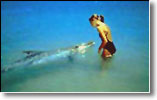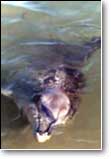

Shark Bay is our number one most important World Heritage Site.
For it is here in Shark Bay that you have the opportunity
to hand-feed the local wild dolphins from the shore in Monkey Mia. Bathe
on Shell Beach - made up of over 6 km (4 miles) of tiny white shells up
to 10 metres (33 feet) deep; and be humbled by the oldest and largest living
fossils in the world - the Hamelin Bay stromatolites. 
The lucky ones may even capture a glimpse of some of the world's near extinct or endangered marine life, including over 10,000 Dugong, the most secure colony of these large air breathing mammals left on earth.
For almost 30 years, 3 generations of wild bottle-nosed dolphins have made a ritual of visiting a remote beach at the small settlement of 'Monkey Mia'. Most mornings between 7.00am and mid-day, small groups of dolphins, all well-known and identified by their distinctive dorsel fin markings, visit the beach to interact with visitors who can walk amongst the dolphins in the shallows and feed them under the supervision rangers.
 The feeding of the Monkey Mia dolphins is very strictly controlled - only freshly
caught local fish are fed to the animals and never
more than one-third of each dolphin's daily food requirement is offered
at the beach. This is to ensure that the animals do not become dependant
on human handouts.
The feeding of the Monkey Mia dolphins is very strictly controlled - only freshly
caught local fish are fed to the animals and never
more than one-third of each dolphin's daily food requirement is offered
at the beach. This is to ensure that the animals do not become dependant
on human handouts.
A separate section of the beach is set aside where visitors can swim with the dolphins and observe their antics and family interactions.
Monkey Mia is one of the most important dolphin research
centres in the world, the clear shallow waters of the bay makes it easy
to observe the animals in their natural environment.
For almost 30 years, 3 generations of wild bottle-nosed dolphins have made a ritual of visiting a remote beach at a small settlement called 'Monkey Mia', 850 kilometres north of Perth.
This beach is located in what is now known as the Shark Bay World Heritage region, an area recognised for its unique marine environment and is home to some of the world's near extinct or endangered marine life, including over 10,000 Dugong, the most secure colony of these large air breathing mammals left on earth.
The many bays, inlets and islands in the Shark Bay region support a profusion of aquatic life. Turtles, whales, prawns, scallops, sea snakes, fish and sharks are common.
Shark Bay was the site of the first European landing in Australia by Dutch Captain Dirk Hartog in 1616 on the Island that now bears his name. With it's early settlements and harsh conditions for the pioneering graziers, along with the hazards, fortunes and tragedy of the early pearlers, Shark Bay has a unique character and charm of the north west towns. Combine this with its pristine environment and its rare and endangered wildlife, visitors agree this is the worlds most important Heritage.
Our adventures which include Shark Bay are: